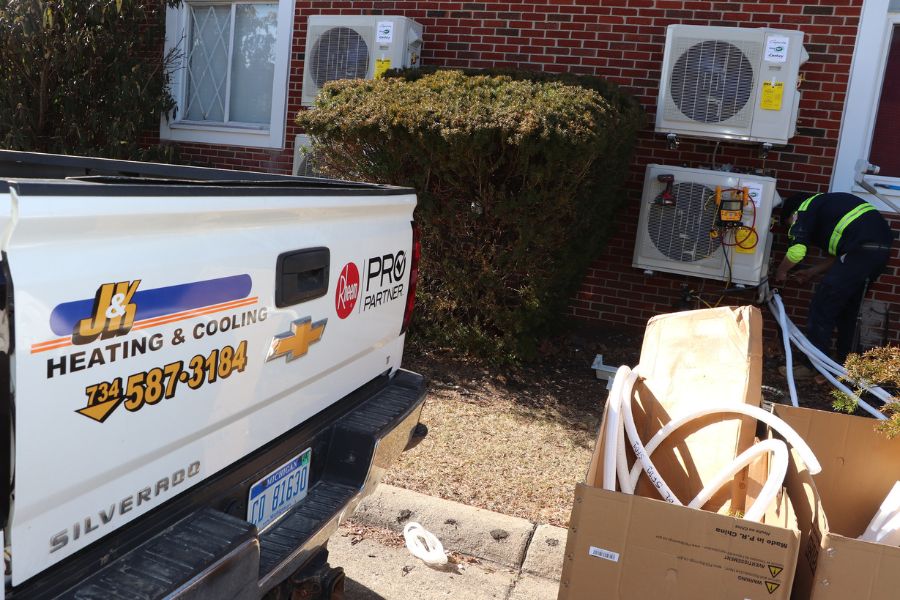Mini-split air conditioners have become increasingly popular due to their efficiency and flexibility. If you’re considering installing a mini-split system in your home or business in Monroe County, Michigan, it’s essential to understand the factors that go into calculating the installation cost.
From the size of the space to the project’s complexity, several factors can impact the overall cost of your mini-split installation. We’ll look at some of the factors which significantly influence the system’s overall cost and its installation by a professional HVAC contractor such as J&K Heating and Cooling.

Unit Size
Unit size is a critical factor that must be considered when installing a mini-split air conditioner. To achieve efficient cooling, homeowners must select a unit that matches the specific requirements of their space in terms of British Thermal Units (BTUs).
Unlike central air systems, mini-splits are designed to cool chosen zones within a home, much like a packaged zoned HVAC system. This means that homeowners must consider the size of the area they intend to cool when deciding on the right unit size. As a rule of thumb, larger spaces require more BTUs, while smaller spaces require less. Undersized AC units won’t cool as well as they should, but oversized units can also be problematic since they use more power and may cycle more often.
The standard mini-split sizes available in the market range from 6,000 to 42,000 BTUs. The cost of mini-split systems varies significantly based on the BTU size, type of air conditioner, and additional charges such as installation fees.
Unit Efficiency
The unit’s efficiency can significantly affect the cost of mini-split air conditioner installation. The efficiency of a unit is determined by its Seasonal Energy Efficiency Ratio (SEER) rating. A higher SEER rating generally means a more efficient and cost-effective system. Most units have better SEER ratings each year, so if you last replaced your AC a while ago, there may be a considerable difference in the SEER of your current system compared to a new one.
Investing in a higher SEER-rated unit can bring several benefits to homeowners. Firstly, it can lower monthly electricity bills, as the system uses less energy to cool the same space. Additionally, many utility companies offer rebates or tax credits to purchase a more efficient system.

Unit Brand
When selecting a ductless mini-split air conditioning system, the brand of the unit is an essential factor to consider. Homeowners should opt for a reliable brand to ensure the longevity and efficiency of the system. At J&K Heating and Cooling, we have several brands for your AC system installation.
Refrigerant Lines
Refrigerant lines are essential parts of split system air conditioner installation. They are responsible for connecting the indoor and outdoor units and transporting refrigerant. The distance between the indoor and exterior units will play a part in pricing for the system. Longer refrigerant lines mean more refrigerant is needed, as well as materials and installation requirements.
Refrigerant lines consist of two copper pipes – one for carrying refrigerant from the outdoor unit to the indoor unit and the other for returning refrigerant to the outdoor unit. Not only will there be costs associated with the longer refrigerant lines, but electrical wiring accompanies the lines going to the exterior unit.
These are just a few factors that will influence the cost of a ductless AC system installation in your home. For a more accurate quote on how much a mini-split AC system costs for your home, be sure to call us here at J&K Heating and Cooling for a free quote!
Frequently Asked Questions
How long does it take to install a split system air conditioner?
The installation time of a split system air conditioner varies from project to project. Generally, it takes about one day for most installations. The amount of time depends on the number of indoor and outdoor units, the length of the refrigerant lines, the type of structure being cooled, and other factors.
Why should I get a split ductless system air conditioner?
Split-system air conditioners are among the most energy-efficient cooling systems available. They are also highly customizable, allowing for multiple zones of cooling in a single home. The installation process is much more straightforward than central air conditioning, which can benefit homes with limited space.





